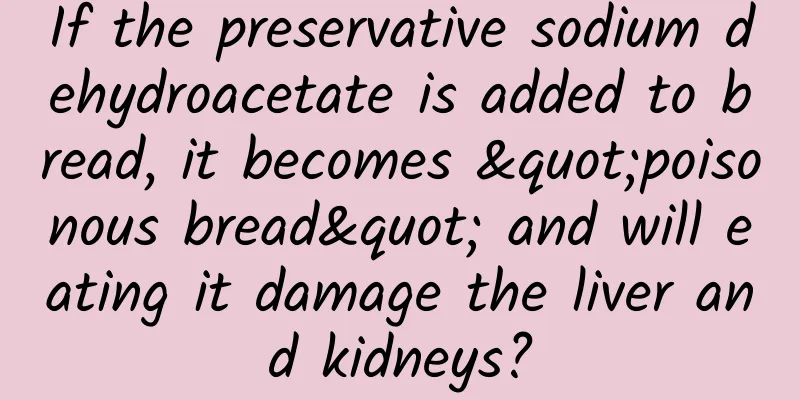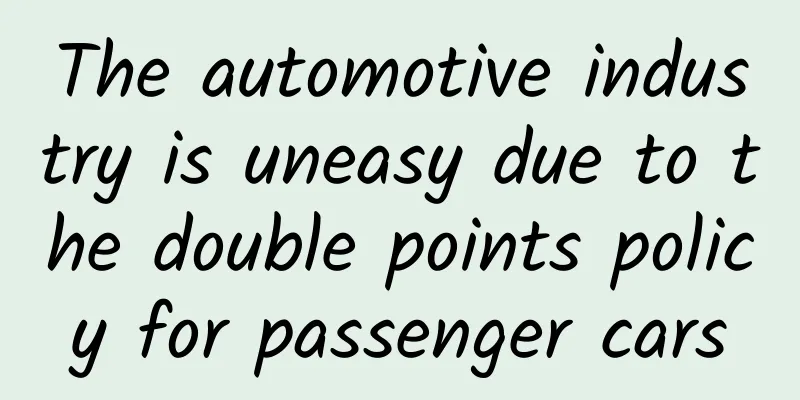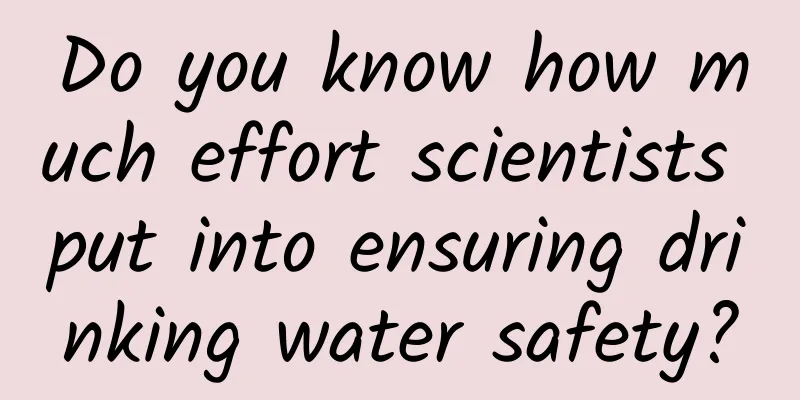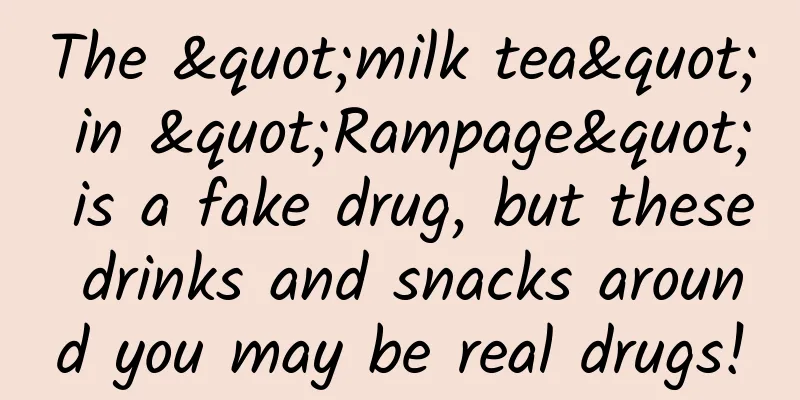If the preservative sodium dehydroacetate is added to bread, it becomes "poisonous bread" and will eating it damage the liver and kidneys?

|
gossip "Bread and other baked goods add the preservative 'sodium dehydroacetate', which becomes 'poisonous bread'. Eating it for a long time will damage the liver and kidney function." Recently, the preservative "sodium dehydroacetate" has become very popular on a certain video platform. A blogger said that eating food containing "sodium dehydroacetate" frequently will damage the liver and kidneys. Some netizens also filmed a video of "ants dying from eating mooncakes", saying that "sodium dehydroacetate" was the "culprit" that caused the ants' deaths. Rumor Analysis That is not the case. First of all, regarding the so-called "ants dying from eating mooncakes containing sodium dehydroacetate" video, we cannot determine from the video alone that the ants died from eating mooncakes. Sodium dehydroacetate is a very common food preservative. According to the results of toxicological studies, sodium dehydroacetate has low toxicity and is safe when used within the range and usage amount specified by the standards. Secondly, the rumor that "sodium dehydroacetate is banned" is actually a misunderstanding of marketing accounts. The "National Food Safety Standard for the Use of Food Additives" (GB 2760-2024), issued in March 2024, only adjusted the scope of use of sodium dehydroacetate, not banned it. Moreover, sodium dehydroacetate is not only used in food, but also in skin care products, cosmetics, personal care products, and even some medicines in our lives. So don't worry too much. Recently, the preservative "sodium dehydroacetate" has become very popular. At first, a video blogger filmed a video of "ants dying from eating mooncakes". In this video, after the mooncakes were placed on the ground, they quickly attracted a group of ants to "visit". The video blogger observed that after a period of time, the ants began to become "less flexible" and "dizzy". Several ants finally remained motionless in the video. The video blogger said that they were "really dead" and then said that the sodium dehydroacetate in the mooncakes was the cause of the ants' death. The picture comes from the Internet Similar evaluation videos have been imitated on short video platforms. Some netizens also said that a batch of mooncakes exported from my country to South Korea were recently returned because South Korea banned the use of sodium dehydroacetate in mooncakes. It just so happened that in the "National Food Safety Standard for the Use of Food Additives" (GB 2760-2024) issued by the National Health Commission in March this year, the use of dehydroacetic acid and its sodium salt in starch products, bread, pastries, baked food fillings and other foods was deleted. At the same time, the maximum usage in pickled vegetables was adjusted from 1 g/kg to 0.3 g/kg (the new standard will be implemented on February 8, 2025). This news was interpreted by many marketing accounts as "sodium dehydroacetate is banned", which made many people more worried. The picture above is the old version, and the picture below is the new version of "National Food Safety Standard Food Additives Usage Standard". So, does sodium dehydroacetate really have safety issues? What is Sodium Dehydroacetate? Sodium Dehydroacetate is a very common food additive. Specifically, sodium dehydroacetate is a preservative. It is characterized by low toxicity, high efficiency, and the ability to inhibit a wide range of microorganisms (i.e., broad spectrum). It can effectively inhibit bacteria, molds, and yeasts to prevent food from spoiling. Other preservatives such as sodium benzoate, calcium propionate, and potassium sorbate usually need to be in an acidic environment to exert their greatest effect, but sodium dehydroacetate has a good preservative effect within a pH range of 4 to 8, which means that it can be more conveniently used in different environments. Therefore, sodium dehydroacetate is widely used in foods to prevent food spoilage, such as bread, pastries, and other foods. Are there any safety issues with sodium dehydroacetate? Let's start with the video of "Ants Died from Eating Mooncakes" on the short video platform. In fact, just from the video, it cannot be judged that the ants died from eating mooncakes. Some netizens questioned that the dead ants were fake and should have been killed by pesticides. The picture comes from the Internet Some netizens also posted their own test results, saying that no ants were found dead, and called on everyone not to follow the crowd. The picture comes from the Internet In fact, according to the results of toxicological studies, sodium dehydroacetate has low toxicity and is safe to use within the range and dosage specified in the standards. In order to argue that "sodium dehydroacetate is toxic and unsafe", some people often cite an analytical paper titled "An Incident of Sodium Dehydroacetate Poisoning in Milk" [1] as their argument. However, this paper was questioned by the academic community after it was published [2]. The expert review opinion believes that the paper is not logically sound and lacks some key epidemiological data (such as the relationship between drinking milk and the onset of disease, whether there are other users besides the children who are sick and their conditions, the incubation period and epidemiological characteristics of the onset group, and the dose-effect relationship between sodium dehydroacetate in milk and the onset of disease). Overall, the evidence is lacking and the conclusion is not rigorous enough. From the perspective of the chain of evidence, the following information needs to be supplemented: (1) the epidemiological association between milk and the onset of disease; (2) the dose relationship between sodium dehydroacetate in milk and the onset of disease in children and the consistency of clinical symptoms. Although the editorial department did not withdraw the article, it invited the unit to publish the results of the epidemiological investigation as soon as possible. However, the follow-up epidemiological investigation results have not yet been seen. Therefore, this study is not enough to show how harmful sodium dehydroacetate is. Is sodium dehydroacetate banned? Many marketing accounts say that "sodium dehydroacetate has been banned", which is a complete distortion and misinterpretation. In fact, this adjustment only adjusted the scope of use of sodium dehydroacetate, not a ban. According to the 2014 version of my country's "National Food Safety Standard for the Use of Food Additives" (GB 2760-2014), sodium dehydroacetate can be used in 12 types of food, including pickled vegetables, bread, pastries, baked food fillings, surface battering, cooked meat products, etc., and its maximum allowable use is 0.5-1.0g/kg (calculated as dehydroacetic acid). According to the announcement of the National Health Commission, the "National Food Safety Standard for the Use of Food Additives" (GB 2760-2024) issued in March 2024 deleted the use of dehydroacetic acid and its sodium salt in starch products, bread, pastries, baked food fillings and other foods, and at the same time reduced its maximum use in pickled vegetables from the original 1 gram/kilogram to 0.3 grams/kilogram. The new standard will be implemented on February 8, 2025, with a one-year transition period. It can be seen that sodium dehydroacetate is still a permitted food additive and can be used in pickled vegetables, fermented bean products, cooked meat products and compound seasonings. Sodium dehydroacetate is also allowed to be used in pickled vegetables, which just shows that the reasonable use of sodium dehydroacetate is still safe. Such range adjustments and limit adjustments are normal management measures. If it is really harmful, there will be no transition period and it will not continue to be allowed to be used in other foods. As for why sodium dehydroacetate is adjusted, there are generally two reasons for re-evaluating a food additive: one is that new evidence has been found on its safety and a re-evaluation is needed; the other is that the food consumption structure has changed. When the consumption of a food changes from a small amount to a large amount, it is necessary to consider whether a certain food additive will exceed the safety limit after accumulation. In recent years, there have been some new discoveries in the toxicological research of sodium dehydroacetate [3][4]. In addition, the consumption of baked goods in my country is gradually increasing. In the past, people ate less baked goods, but now people's lives have changed a lot. More than 90% of consumers buy baked goods every week and eat more. There is another very important reason. There are many other preservatives that can be used, such as sodium benzoate, potassium sorbate, etc., and not using sodium dehydroacetate will not affect product production. Therefore, this time we made adjustments. Sodium dehydroacetate is not used abroad? Some people also say that sodium dehydroacetate is not used in foreign countries, especially in Japan, South Korea, and the United States. This is also completely wrong. South Korea stipulates that sodium dehydroacetate can be used in cheese, butter, and margarine, but the amount must not exceed 0.5g/kg. However, they do not allow it to be used in mooncakes. Therefore, if sodium dehydroacetate is used in the mooncakes we export to South Korea, they will not comply with their regulations. Similarly, if sodium dehydroacetate is used in the cheese, butter, and margarine they export to us, they will also not comply with our regulations. The United States allows sodium dehydroacetate to be used in diced or peeled pumpkin and strawberries, with a maximum usage of no more than 65mg/kg [5]. Japan allows sodium dehydroacetate to be used in butter, cheese, margarine, and other foods, with a maximum usage of no more than 0.5g/kg [6]. It can be seen that the regulations on the use of sodium dehydroacetate in foreign countries are different from ours. But in general, whether to use it or not, and where to use it, are completely different management methods and have nothing to do with safety. Moreover, sodium dehydroacetate is not only used in food, but also in our skin care products, cosmetics, personal care products [7], and even some medicines. A facial cleanser ingredient list Body lotion ingredient list Correctly View Food Additives Now the new standard has not come into effect, and sodium dehydroacetate is still being used. So, can we still eat food containing this additive? When the standard was issued, a transition period of nearly one year was given, and it will not be officially implemented until February next year. In fact, it also shows that it is safe. There are many cosmetics and daily necessities in daily life that also contain it. Therefore, you still don’t have to worry too much. As long as it is produced in compliance with regulations, you can still buy it with confidence. I hope that everyone will not change their color when it comes to food additives. The use of food additives is to improve food quality and ensure our safety and health. You must know that once food is contaminated with microorganisms, the health risks of food spoilage caused by the growth and reproduction of microorganisms may be much greater. For example, there are many meat-filled moon cakes now. If bacteria breed and produce harmful substances, the harm to health once people eat them will be much greater; if sausages are not used with preservatives, they may be contaminated by Clostridium botulinum to produce deadly botulinum toxin. Reasonable use of food additives will not cause harm to health. The use of food additives will adjust the variety or scope of application and usage according to the latest research progress. These are normal management adjustments. Everyone should keep a normal mind and develop the habit of reasonable food matching. Looking in the mirror of rumors Rumors about "food additives" have always been a hotbed of rumors. In daily life, you can learn more about the basic knowledge of food additives, including their effects, how to use them, and safe dosages, so that you can better judge the authenticity of information. At the same time, pay attention to statements that use exaggerated or emotional language, such as "toxic" and "carcinogenic", which are often intended to attract attention rather than convey facts. Don't be afraid of food additives. Reasonable use of food additives will not harm your health. References [1] Liu Feng, Xu Fei, Yuan Xiujuan, et al. Investigation and analysis of a sodium dehydroacetate poisoning incident in milk[J]. Chinese Journal of Food Hygiene, 2019, 31(05): 490-493. DOI: 10.13590/j.cjfh.2019.05.018. [2] Response to the article “Investigation and analysis of a sodium dehydroacetate poisoning incident in milk” [J]. Chinese Journal of Food Hygiene, 2020, 32(03): 348-350. [3] Du Hongju, Tong Guohui, Ning Junyu, et al. Study on acute and subacute toxicity of food additive sodium dehydroacetate [C]//Chinese Society of Toxicology, Taiwan Society of Toxicology. Proceedings of the 2019 Cross-Strait and Hong Kong and Macao Young Scientists Toxicology Academic Exchange Conference. Beijing Center for Disease Control and Prevention/Beijing Key Laboratory of Food Poisoning Diagnosis and Traceability Technology, Institute of Hygiene Toxicology, Beijing Center for Preventive Medicine Research;, 2019:2. [4] Geng Xue, Zhang Xiaopeng, Li Yongning, et al. Study on genetic toxicity of sodium dehydroacetate[J]. Chinese Journal of Food Hygiene, 2020, 32(02): 118-123. DOI: 10.13590/j.cjfh.2020.02.002. [5]United States Food and Drug Administration. 21CFR172.130-Code of Federal Regulations Title 21[EB/OL]. (2019-04)[2020-04-28]. [6]SAKAGUCHI Y,SUGA S,OSHIDA K,et al.Anticoagulant effect of sodium dehydroacetate (DHA-S) in rats[J].Journal of Applied Toxicology,2008,28(4):524-529. [7]Cherian, P; Bergfeld, WF; (...); Heldreth, B. Sodium Dehydroacetate and Dehydroacetic Acid. International Journal of Toxicology, 2024. Jun 2024 (Early Access) Author: Ruan Guangfeng, Deputy Director of Kexin Food and Health Information Exchange Center Review丨Zhang Yu, researcher/PhD, Chinese Center for Disease Control and Prevention, national health science expert |
>>: Build a "space bridge"! How does satellite Internet become the "new infrastructure" in space?
Recommend
Private tips on how to place game information streams, told to you for free!
Before reading this article, we need to have a co...
Wuhan becomes China's version of Phoenix, autonomous driving takes off at the beginning of the year
Wuhan is an ancient yet young city. The historica...
How to transform a brand from "traffic" to "retention"
01 This article is full of high energy and reveals...
No more "crashes", Tingyun App can help you increase your APP's user retention rate by 20%
Maybe no one cares, but "frustrating" t...
Forget to take off contact lenses when sleeping, eyeballs turn white and you may go blind! What should you pay attention to when wearing contact lenses?
Recently, a 23-year-old man in Jinan, Shandong fo...
How many plans can a bidding promotion account be divided into at most?
(1). You can create up to 100 promotion plans, an...
Chen Jiangxiong-Douyin Follower Increase and Traffic Training Camp
Chen Jiangxiong's Douyin fan increase and tra...
You will definitely understand what iteration means.
Editor's Note There is an interesting phenome...
There are pitfalls when it comes to selling products with influencers!
Not all live streaming sales by internet celebrit...
A cup of instant coffee every day may shorten your lifespan? Don’t worry, I recommend you drink this!
Coffee is a must-have for working people. If you ...
Oxylabs experts discuss whether reinforcement (machine) learning is overhyped?
Suppose you sit down to play chess with a friend,...
Is Bullet Messenger really that useful? Or is the desire to escape from the circle of friends too strong?
Editor's note: 80s, 90s, 00s - rather than ri...
How to operate and promote a new app? What should be done before and after going online?
Before talking about the operation of an App , it...
Asian Games are coming soon, take care of your knees, save this "white list" of knee joint exercises
Hangzhou Asian Games is about to be held If you l...
With a continuous monthly growth of 50%+, how can brand marketing promotion go from 0 to 1?
The process of brand creation can be mainly divid...









